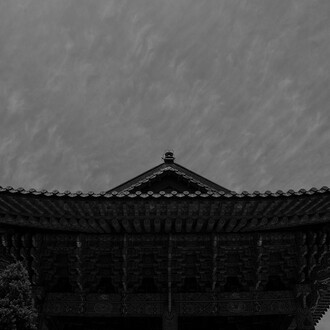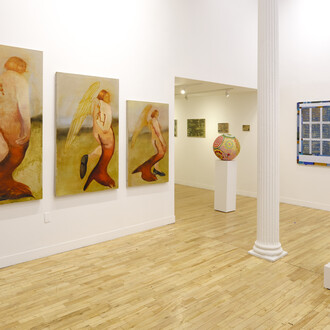Felines and canines occupy an interesting and historically robust relationship within the annals of art history. From Pierre-Auguste Renoir's Child with Cat (Julie Manet) (1887) to Andy Warhol's cat lithographs, i.e. 25 Cats Named Sam and One Blue Pussy (1954), and Lavinia Fontana famous painting, Portrait of a Noblewoman (1580), cats and dogs have been a recurrent motif for many visual artists and painters. In some traditions, the use of the cat and the dog has served simply the whimsy of portraiture; other artists have used the cat or dog as a symbolic relic with which to embody theological themes. Notably, Young Kyoon Kim's terracotta sculptures and Su Young Lim's natural mineral pigments and dyed mud pigments on silk are in continuity with these traditions, as both artists have taken the figure of the dog as their muse. However, both Kim and Lim also advance the motif of the dog beyond the aforementioned artists.
Young Kyoon Kim's terracotta works feature a whimsical, recurrent dog. The dog has orange-auburn fur, a brownish nose, and an ashen-white underbelly. Often, this dog is poised in regal stature, eyes closed, and an almost-anthropomorphic smile cast across its cheeks. The work is an example of an artwork effectively evoking a veridical emotional response over drawing simple likeness; due to the medium and the style of sculpture that Kim pursues, the dogs are often caught into animated poses—one might even deem them “cinematic” at points, like isolated frames from a film. Balled up and hunched, the dogs sometime seem ready to pounce or brush their head against the viewer. One of the most impressive works features the dog splayed across its back, its doughy alabaster stomach revealed. These poses will be familiar to all who have owned or interacted with dogs. In turn, Kim does an admirable job of giving us familial snapshots and proffering the amusing, lively site of sculpture as a foundation for intimacy. Kim’s paintings are not works that aim to philosophically challenge us but instead serve both decorative purposes and are restorative. That is, glancing at these ebullient dogs, one cannot help but smile to oneself and gleam some therapeutic vim.
Some of Kim’s terracotta sculptures feature the dog paired with one or two more of its mates; in exaggerated poses with paws open and backs stretched, these dogs seem to be cast in eternal conversation. As I noted earlier, the theme of anthropomorphizing is lightly imbued in some of the faint details of these works, including the light smiles one might make out between the dog’s lips. This theme is only affirmed (if not underscored) in certain works where Kim renders the dog half-cherub. In a most inventive work, we see how underneath the mask of the dog peers a cast child, raising his arms and chest out of the dog-fur legs and pouncing through the torso of the dog-figure. Like a faun, minotaur, or some other mythological creature, this figure straddles the thin line between man and animal. This work in particular is quite curious, insofar as it both frames the technique of anthropomorphizing as it is subtly utilized in the other works and introduces questions related to the distinct cut-off between man and animal. Such questions include what, exactly, discerns one from the other: is it sapience, or perhaps being able to give and ask for reasons about what one believes/takes to be the case. Despite the innocence with which the dog sculptures are introduced, in their out-stretched charming mode, the works do also introduce such further questioning.
Young Lim's works often feature a very similar dog to Kim's: ash-brown and dark-flaxen fur is bifurcated by bright tufts of white hair. However, Lim, contra Kim, does not stick with one single dock, as an array of dogs is often featured, including an all-white, snowflake-like dog. One of the most interesting features of Lim's work is their inventive use of the background vis-à-vis handmade paper canvases. Throughout these works, Lim also incorporates a mud-amber background evocative of traditional Korean painting, which adds to the possibility that the dogs play a symbolic role (as animals always do in Minhwa painting). Many of Lim’s works also feature the figure of the human alongside the dog, including one of the aforementioned brown-white dog perched behind the torso of a human who hands down a feeding bowl. Sometimes scattered relics and signs of human activity abound, including single discarded shoes and disheveled blankets. The dogs are often also robed in brightly lit clothing, including one such image of two dogs donned in sweaters—one crimson-and-white, reminiscent of a shining candy-cane, and the other robed in bright blue-and-red; a carved heart is detailed on both dogs' sweaters and their tails are neatly arced, almost as if they are coordinated. On the one hand, the dog sweaters are rather commonplace and a cute embellishment; however, like Lim, Kim’s work and its integration of the motif of the dog with that of the human also unspools a series of questions about the identity/relationship between dog and person.
Kim and Lim’s work, first and foremost, reminds us that visual art can be genuinely fun. Indeed, both Kim and Lim’s ever-whimsical scenes are highly inviting and most enjoyable to get lost in. However, it is also worth underscoring that while both contributions explore the boisterous and the convivial, they also subtly experiment with anthropomorphizing non-human figuration.
(Review written by Art Critic Ekin Erkan, PhD in Philosopy)
















